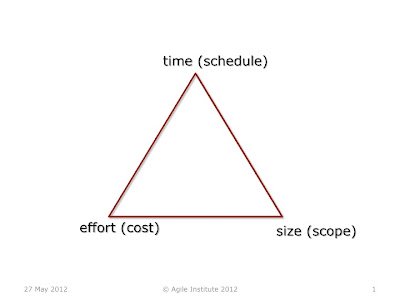 |
| The Classic Iron Triangle |
(Re-)Introducing the Iron Triangle
You and your team, division, tribe, or organization are given a task. You must complete the whole project, you don't have extra money to hire more people, and it has to be completed by a specified date. This is known as the "Triple Constraint" or the "Iron Triangle": All variables have been pinned down: They're not really variable by the time you see them.
If the project does succeed, the next project will be constrained further. "Good job! Now let's see you do more with less."
Despite the fact that we've known for thousands of years that this arrangement is likely doomed to fail, the Iron Triangle still survives within many corporate cultures.
Why don't we see the fallacy behind the Iron Triangle? (1) Because the failures occur after the project is completed. And (2) because the Iron Triangle itself is a flimsy model.
 |
| Performance as a Function of Time, Effort, and Size |
Performance According to the Five Core Metrics
I must have misread this book. I recall reading about time, effort, and size, and then reading about how performance is a function of the other three. Let's see, how many metrics is that? 1 + 3 = 4.
Then the 5th metric is introduced: Quality!
I recall being stunned that it wasn't included in the performance equation. Were the authors really suggesting that, as long as we meet the Triple Constraints, we were providing value even if we were producing total crap?
I must have misread this book.
Remember Quality
I used to start this client-coach conversation with "slow down to speed up." The problem with "slow down to speed up" is that it's as valuable as "buy low, sell high": True, but absolutely useless.
 |
| The Wobbly Iron Rhomboid |
A better metaphor is that of the chef who sharpens her knives before cooking. This simple practice makes chopping safer, and thus the chef can chop with more confidence that the knife is going to go where she wants it to go. All chefs learn this, and those who choose not to follow this simple advice often end up with a mangled finger, a trip to the ER, or worse. Skipping this essential practice is a false "short cut" that leads to wasted time, effort, and money.
Software development is chock full of false short cuts. When we ask our teams to deliver everything, on-time, at cost, we have pinned down the three corners of the Iron Triangle. Of course the team will find ways to achieve your goals, consciously or unconsciously. And there's only one place where the Wobbly Iron Rhomboid can wiggle if those three corners are pinned: Quality will suffer.
"Yay! We've released version 1.0!" A resounding victory, until the customers start to use the product.
Lead with Quality
I consider myself experienced enough to know why start-ups need to rush to market. And yet, having worked on both highly successful software, and at least two disastrous VC-funded dot-COM start-ups, I have noted this: Companies and products do much better over time if they deliver fast, and they deliver less than everything, with high quality.
What do you get when you add features to buggy code? More buggy features. If the feature doesn't work, the product hasn't provided the intended value, and the customers wander off. When we push teams to deliver more and more functionality, without giving them the routine breathing room to pay down the technical debt created by rushing, we risk product melt-down.
The team must be encouraged, very early on, to establish disciplines that create high-quality features, and preserve the quality of those features over time.
Teams who do this frequently discover that these same disciplines improve their ability to add features later on, reducing the time it takes for an innovative new feature to reach production. In other words, disciplines that establish and preserve high quality also improve the throughput of value.
So, as with every "Iron Cage Death Match," everyone wins. By building quality in, productivity--the real throughput of value--is also increased.
How does a software development team "sharpen the chef's knives"? Stay tuned!
